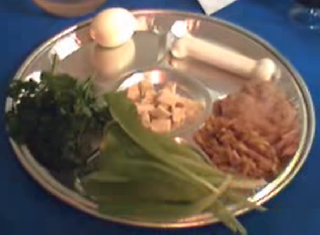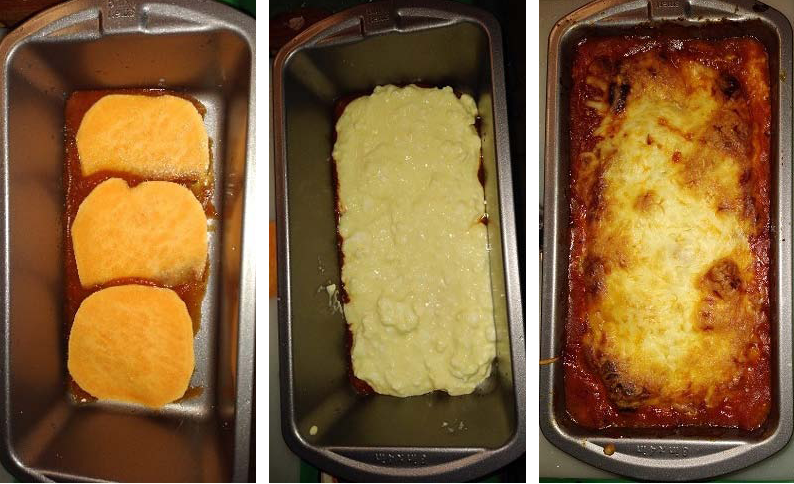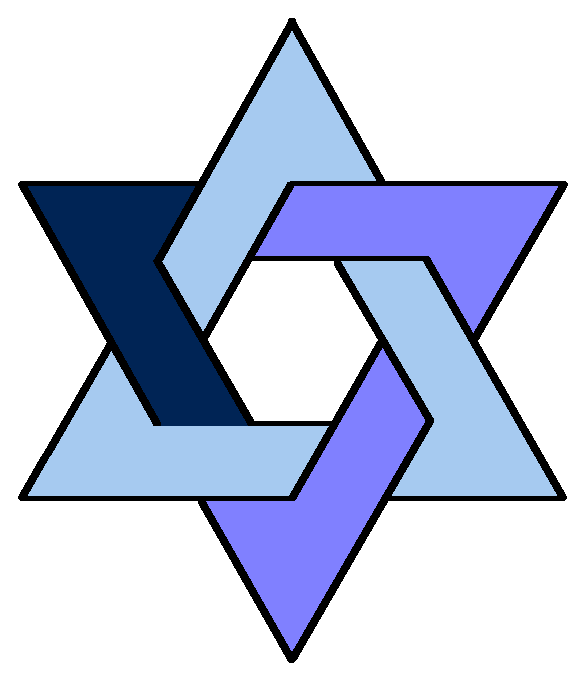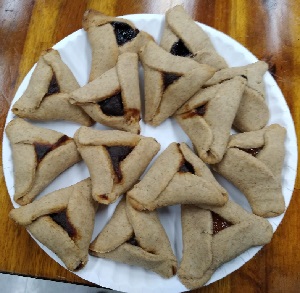
Level: Basic
And this day shall become a memorial for you, and you shall observe it as a festival for the L-RD, for your generations, as an eternal decree shall you observe it. For seven days you shall eat unleavened bread, but on the first day you shall remove the leaven from your homes ... you shall guard the unleavened bread, because on this very day I will take you out of the land of Egypt; you shall observe this day for your generations as an eternal decree. (Exodus 12:14-17)
Pesach, known in English as Passover, is one of the most commonly observed Jewish holidays, even by otherwise non-observant Jews. According to a 2020 Pew Research Center survey, 60% of Jews attended a seder the year before the survey, including 30% of those who identified as Jews of no religion.
Pesach begins on the 15th day of the Jewish month of Nissan. It is the first of the three major festivals with both historical and agricultural significance (the other two are Shavu'ot and Sukkot). Agriculturally, it represents the beginning of the harvest season in Israel, but little attention is paid to this aspect of the holiday. The primary observances of Pesach are related to the Exodus from Egypt after generations of slavery. This story is told in Exodus, Ch. 1-15. Many of the familiar Pesach observances are instituted in Exodus Ch. 12-15.
The name "Pesach" (PAY-sahch or PEH-sahch, with a "ch" as in the Scottish "loch") comes from the Hebrew root Pei-Samekh-Cheit פסח, meaning to pass through, to pass over, to exempt or to spare. It refers to the fact that G-d "passed over" the houses of the Jews when He was slaying the firstborn of Egypt. In English, the holiday is known as Passover. "Pesach" is also the name of the sacrifice (a lamb) that was offered in the Temple on this holiday. The holiday is also referred to as Chag he-Aviv חַג הֶאָבִיב (the Spring Festival), Chag ha-Matzot חַג הַמַּצּוֹת (the Festival of Matzahs), and Z'man Cheiruteinu זְמַן חֵרוּתֵנוּ (the Time of Our Freedom) (again, all with those Scottish "ch"s).
Probably the most significant observance related to Pesach involves avoiding chametz חָמֵץ (leaven; sounds like "hum it's" with that Scottish "ch") throughout the holiday. This commemorates the fact that the Jews leaving Egypt were in a hurry, and did not have time to let their bread rise. It is also a symbolic way of removing the "puffiness" (arrogance, pride) from our souls.
Chametz includes anything made from the five major grains (wheat, rye, barley, oats and spelt) that has not been completely cooked within 18 minutes after first coming into contact with water. Many people also avoid rice, corn, peanuts, legumes (beans) and some other foods. More about that under Kitniyot below.
We are not allowed to eat chametz during Pesach; we are not allowed to own it or derive benefit from it. We cannot even feed it to our pets or cattle. All chametz, including utensils used to cook chametz, must either be disposed of or sold to a non-Jew (they are repurchased after the holiday). Pets' diets must be changed for the holiday (my pet hamster LOVED this holiday -- nuts and vegetables instead of kibble), or the pets must be sold to a non-Jew (like the food and utensils, the pets do not leave the home and are repurchased after the holiday ends). You can sell your chametz online through Chabad-Lubavitch. I have noticed that many non-Jews and non-observant Jews mock this practice of selling chametz as an artificial technicality. I assure you that this sale is very real and legally binding, and would not be valid under Jewish law if it were not. From the gentile's perspective, the purchase functions much like the buying and selling of futures on the stock market: even though he does not take physical possession of the goods, his temporary legal ownership of those goods is very real and potentially profitable.
The process of cleaning the home of all chametz in preparation for Pesach is an enormous task. To do it right, you must prepare for several weeks and spend several days scrubbing everything down, going over the edges of your stove and fridge with a toothpick and a Q-Tip, covering all surfaces that come in contact with food with foil or shelf-liner, etc., etc., etc. After the cleaning is completed, the morning before the seder, a formal search of the house for chametz is undertaken, and any remaining chametz is burned.
The grain product we eat during Pesach is called matzah. Matzah is unleavened bread, made simply from flour and water and cooked very quickly. This is the bread that the Jews made for their flight from Egypt. We have come up with many inventive ways to use matzah. It is available in a variety of textures for cooking: matzah flour (finely ground for cakes and cookies), matzah meal (coarsely ground, used as a bread crumb substitute), matzah farfel (little chunks, a noodle or crouton substitute), and full-sized matzah (sheets about 8 inch square, a bread substitute).
Some people observe an additional strictness during Pesach known as gebrochts, from a Yiddish word meaning "broken," although I'm not sure what brokenness has to do with this restriction. Those who observe gebrochts (or more accurately, "no gebrochts") will avoid any matzah product that has come into contact with liquid after being baked. The rule arises from a concern that matzah may contain bits of flour that were not completely cooked and that would become leavened upon contact with liquid. People who observe this strictness cannot eat many common traditional Pesach dishes, such as matzah ball soup, and cannot even eat charoset on matzah at seder. They are careful not to spill seder wine on their matzah, and promptly remove the wine spilled as part of the seder. Observance of this additional restriction is not common, but many people become exposed to it because it is followed by the Chabad-Lubavitch, who are active in Jewish education. Some have criticized gebrochts for unnecessarily complicating Pesach and taking some of the joy out of this celebration of freedom for no good reason, noting that the premise of this rule contradicts codes of Jewish law that explicitly say it is impossible for matzah to become chametz once it is baked. Nevertheless, this effort to more fully observe G-d's law is worthy of respect, even if you are not inclined to add this restriction to your own Pesach experience.
The day before Pesach is the Fast of the Firstborn, a minor fast for all firstborn males, commemorating the fact that the firstborn Jewish males in Egypt were not killed during the final plague.
On the first night of Pesach (first two nights for traditional Jews outside Israel), we have a special family meal filled with ritual to remind us of the significance of the holiday. This meal is called a seder סֵדֶר from a Hebrew root word meaning "order," because there is a specific set of information that must be discussed in a specific order. It is the same root from which we derive the word "siddur" סִדּוּר (prayer book). An overview of a traditional seder is included below.
Pesach lasts for eight days (seven days in Israel). The first two days and last two days of the holiday (first and last in Israel) are days on which no work is permitted. See Extra Day of Holidays for more information. Work is permitted on the intermediate days. These intermediate days on which work is permitted are referred to as Chol Ha-Mo'ed, as are the intermediate days of Sukkot.
Occasionally, Pesach begins on a motza'ei Shabbat, that is, on Saturday night after the Sabbath has concluded. It occurred in 5781 (2021) and will occur again in 5785 (2025), but after that it will not happen until 5805 (2045)! This complicates the process of preparing for Pesach, because many of the preparations normally undertaken on the day before Pesach cannot be performed on Shabbat.
The Fast of the Firstborn, normally observed on the day before Pesach, is observed on Thursday instead. The search for chametz, normally performed on the night before Pesach, is performed on Thursday night. The seder should be prepared for as much as possible before Shabbat begins, because time should not be taken away from Shabbat to prepare for Pesach. In addition, there are severe complications dealing with the conflict between the requirement of removing chametz no later than mid-morning on Saturday, the prohibition against eating matzah on the day before the seder, and the requirement of eating three meals with bread during Shabbat! For further details, see an excellent summary from the Orthodox Union, the world's largest, oldest and perhaps most respected kosher certification agency.
And if your son asks you in the future, saying, What are the testimonies, and the statutes, and the judgments, that the L-RD our G-d commanded you? You will say to your son, We were slaves to Pharaoh in Egypt; and the L-RD brought us out of Egypt with a mighty hand. The L-RD gave signs and wonders, great and harmful, against Egypt, against Pharaoh, and against all his household, before our eyes: And he brought us out of there to bring us in, to give us the land that he promised our fathers. -Deuteronomy 6:20-23
The text of the Pesach seder is written in a book called the haggadah הַגָדָה. The haggadah tells the story of the Exodus from Egypt and explains some of the practices and symbols of the holiday. Suggestions for buying a haggadah are included below. The content of the seder can be summed up by the following Hebrew rhyme:
Now, what does that mean?
For more information about how the Pesach seder compares to a traditional Jewish weekday, Shabbat or holiday meal, see Pesach Seder: How is This Night Different.
Many people think of Pesach as a time of deprivation: a time when we cannot eat bread or other leavened foods. This is not the traditional way of viewing the holiday. Pesach is Z'man Cheiruteinu, the Time of Our Freedom, and the joy of that time is evident in the music of the season. There are many joyous songs sung during the seder.
This is one of the most popular tunes of the seder, a very up-beat song about the many favors that G-d bestowed upon us when He brought us out of Egypt. The song appears in the haggadah after the telling of the story of the exodus, just before the explanation of Pesach, Matzah and Maror (followed by dinner, which is another reason for the popularity of the song: food is coming very soon!). I provide just two sample verses from a rather long song. The English does not include all of the repetition that is in the Hebrew. The Maccabeats video from YouTube uses the traditional melody but again, much more elaborate than the average household! They are also using slightly different lyrics than the ones from my haggadah below.
Many people sing this song when the Cup of Elijah is poured and the door is opened in anticipation of his return. This song is also commonly sung at the end of Shabbat, which is why the YouTube video discusses Shabbat at the beginning.
This fruit, nut and wine mix is eaten during the seder. It is meant to remind us of the mortar used by the Jews to build during the period of slavery. I like it with a coarse texture, but some people make it with a smoother texture, more like cement. The ingredient quantities listed here are at best a rough estimate; I usually just eye-ball it. The recipe below makes a very large quantity, but we usually wind up making more before the holiday is over. Other fruits or nuts can be used.
Shred the apples. Add all other ingredients. Allow to sit for 3-6 hours, until the wine is absorbed by the other ingredients. Serve on matzah. Goes very well with horseradish.
If you want to know more about Pesach, the best place to start is with the haggadah. The haggadah was written as a teaching tool, to allow people at all levels to learn the significance of Pesach and its symbols.
There are a wide variety of Haggadahs available for every political and religious point of view: traditional haggadahs, liberal haggadahs, mystical haggadahs, feminist haggadahs, and others. I have even seen what might be described as an atheist haggadah: one that does not mention the role of G-d in the Exodus.
If you're buying a haggadah for study or collection, there are many haggadahs with extensive commentary or with pictures from illuminated medieval haggadahs. However, if you're buying haggadahs for actual use at a seder, you're best off with an inexpensive paperback. Keep in mind that you'll need one for everybody, you're likely to get food and wine on these things, and you'll be using them year after year.
I'm particularly partial to the Artscroll/Mesorah series' The Family Haggadah. It has the full, Orthodox text of the haggadah in English side-by-side with Hebrew and Aramaic, with complete instructions for preparing for and performing the seder. The translations are very readable and the book includes marginal notes explaining the significance of each paragraph of the text. This book is usually only available at Jewish gift or book stores, and usually sells for about $4.
Another good traditional one is Nathan Goldberg's Passover Haggadah. This is the familiar "yellow and red cover" haggadah that so many of us grew up with. Believe it or not, it is frequently available in grocery stores in the Passover aisle. It usually sells for about $3, and is often given away free with certain grocery purchases.
For those who want a shorter seder, a friend of mine recomments 30 Minute Seder: The Haggadah That Blends Brevity With Tradition, a haggadah that cuts the text down without losing anything necessary for a complete seder. The text is written in plain English with Hebrew for prayers.
Watch out for Christianized versions of the haggadah. The Christian "last supper" is generally believed to have been a Pesach seder, so many Christians recreate the ritual of the seder, and the haggadahs that they use for this purpose tend to reinterpret the significance of the holiday and its symbols to fit into their Christian theology. For example, they say that the three matzahs represent the Trinity, with the broken one representing Jesus on the cross (in Judaism, the three matzahs represent the three Temples, two of which have been destroyed, and the third of which will be built when the mashiach comes). They speak of the paschal lamb as a prophecy of Jesus, rather than a remembrance of the lamb's blood on the doorposts in Egypt. If you want to learn what Pesach means to Jews, then these "messianic" haggadahs aren't for you.
Are you looking for a place to attend a Pesach seder? Chabad-Lubavitch sponsors Pesach seders all around the country. You can search for a seder in your area using their International Seder Directory.
Note: Pronunciations are intended to reflect the way these terms are most commonly pronounced by Jews in the United States, and may sound different when pronounced by Israelis or purists.
Kitniyot (pronounced kit-NEE-oht or as in Yiddish, KIT-nee-ohss) are rice, corn, peanuts, legumes (beans) and some other foods. These foods are not the forbidden five grains but they are avoided during Pesach due to a long-standing minhag (custom). The Hebrew word kitniyot means legumes.
This minhag developed in Central Europe (France, Germany) in the Middle Ages, and the custom followed their descendants East to Hungary, Poland and Russia and West to America. The rabbis of that time and place ruled that certain foods should not be eaten during Pesach because they are commonly used to make bread, or are grown and processed near chametz, which could lead to confusion or cross-contamination. Some Sephardic rabbis expressed similar concerns, but the restriction never caught on in that community, and rice and beans are a staple Pesach food among Sephardim. This leads to the oddity that certain foods may be marked as kosher for Passover even though some people would not consider them acceptable. I remember when I was in college, my Hillel gave out the Israeli candy, Joyva Sesame Crunch, which was clearly labelled Kosher for Passover, but contains corn syrup, which is kitniyot. It is increasingly common for such certifications to say, "Kosher for Passover for those who allow kitniyot" or words to that effect.
In America, the Reform movement rejected the restriction on kitniyot in 1810. Of course, the Reform movement is not particularly strict about dietary laws of any kind, so that ruling didn't spread beyond their boundaries. Even within the Reform movement, some people avoided these things because, as a Reform friend of mine once said, "That's just not what my people eat." The Conservative movement in Israel lifted this restriction in 1989, because half of the population of Israel is Sephardic and there was increasing intermarrage between Sephardim and Ashkenazim, leading to the problem that people couldn't eat with their own relatives! In 2016, the Conservative movement brought that ruling to America, with much less persuasive reasoning, talking about the health benefits of beans and grains particularly for vegetarians, even though you can easily make many good kitniyot-free vegetarian recipes (see them on my blog). Many American Conservative Jews continue to avoid kitniyot, in part because of custom and tradition and in part because foods with kitniyot aren't certified in America. The Orthodox movement, of course, continues to strictly observe this long-standing custom.
I've put together a video on YouTube that explains the items on the seder table and another discussing the beginning of the seder. I hope to have more of the seder on YouTube soon.
Pesach will occur on the following days of the secular calendar:
For additional holiday dates, see Links to Jewish Calendars.
 Pesach Seder: How is This Night Different
Pesach Seder: How is This Night Different Pesach (Passover) Cooking Tips
Pesach (Passover) Cooking Tips Counting of Omer
Counting of Omer Next Holiday: Shavu'ot
Next Holiday: Shavu'ot Last Holiday: Purim!
Last Holiday: Purim!